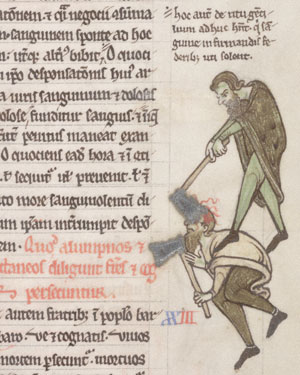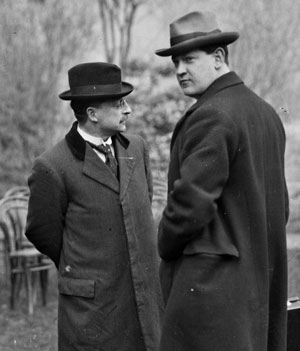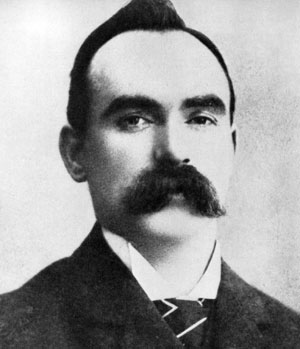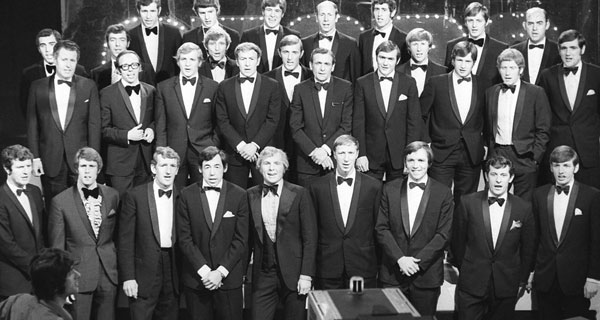CONTEMPORARY: From Baginbun to Brexit—the shadow of Strongbow
Published in Features, Issue 3 (May/June 2019), Volume 27For many separatists, not only had Ireland lost its independence with Strongbow’s arrival but the other evils of foreign rule could also be traced to that era.
By Brian Hanley

Above: The Irish as treacherous axe-killers—from the margin of Gerald of Wales’s Topography. We do not have to romanticise Gaelic society or think that the native aristocracy were democrats to understand that their conquerors sought to portray them in ways that justified their suppression. (NLI)
Strongbow has cast a long shadow over Irish history. When Irish republicans demanded independence a century ago they believed that they were undoing a process that had begun with his arrival in 1170. The First Dáil asserted that ‘for seven hundred years the Irish people has never ceased to repudiate … foreign usurpation’, while the same body’s ‘Message to the Free Nations’ spoke of Ireland preserving its ‘national integrity’ despite ‘seven centuries of foreign oppression’. Michael Collins claimed that ‘for 700 years the united effort has been to get the English out of Ireland’. In July 1921, as this struggle looked to be approaching a successful climax, one of Collins’s key men, Eamon Broy, ‘could not help a feeling of exultation that the Irish nation had been recognized at last … the first recognition since the arrival of Strongbow. The Truce might well be the beginning of the end, as indeed it was, of seven and a half centuries of English occupation.’ With the signing of the Treaty influential Irish-American Senator Bourke Cockron declared that ‘for the first time since Strongbow Ireland was now a free and independent nation’, while a Cork republican claimed that ‘the Treaty forced [Britain] to concede to Ireland what Ireland never hoped for since Strongbow infested our country: the evacuation of the invader from the holy soil of Ireland’. There were echoes of 1169/70 throughout the Treaty debates. Arthur Griffith told the Dáil that ‘we have brought back the evacuation of Ireland after 700 years by British troops’. Longford IRA leader Seán MacEoin claimed that the Treaty gave ‘Ireland the chance for the first time in 700 years to develop her own life in her own way … it gives us for the first time in 700 years the evacuation of Britain’s armed forces out of Ireland’. Mayo TD William Sears asserted that for ‘the first time in 700 years the English army is to march out of Ireland’. (Readers may note that referring to the 26 counties as ‘Ireland’ is not a new phenomenon.) In contrast, anti-Treatyite J.J. O’Kelly claimed that until July 1921 the Irish cause had been ‘on the proudest plane it had occupied since Strongbow landed in Ireland’ but that in signing the Treaty they had taken it ‘off that plane onto a slippery slope’. In turn, Arthur Griffith warned republicans that if they refused to accept the electorate’s verdict on the Treaty they would ‘go down to future generations with the brand of Dermot MacMurrough—as the greatest traitors in Irish history’.
‘Norman thief and Irish traitor’

Above: Arthur Griffith—‘We have brought back the evacuation of Ireland after 700 years by British troops’—and Michael Collins—‘For 700 years the united effort has been to get the English out of Ireland’.
For many separatists, not only had Ireland lost its independence with Strongbow’s arrival but the other evils of foreign rule could also be traced to that era. James Connolly described ‘landlord tyranny, capitalist fraud and unclean usury’ as the ‘baneful fruits of the Norman Conquest, the unholy trinity, of which Strongbow and Diarmuid MacMurchada—Norman thief and Irish traitor—were the fitting precursors and apostles’. Michael Collins reflected in The path to freedom that ‘our national freedom depends upon the extent to which we reverse the history of the last 700 years, the extent to which we get rid of the enemy and get rid of his control over our material and spiritual life’. Discussing a new land bill in 1923, Cumann na nGaedheal’s Seamus Burke argued that the Free State was ‘undoing … the conquest of Ireland’ and that the new legislation would be an ‘outward sign and symbol of the victory of the Gael over the Gaul … The victory of the Irish natured occupiers of the soil over the descendants of the followers of Strongbow.’
But it is not fashionable now to talk seriously about ‘800 years of oppression’ (or even 850 years). Certainly few historians regard the story of Ireland’s relationship with Britain as one of unbroken resistance since 1169. And the separatists of the last century ignored numerous contradictions when they spoke as Thomas Ashe did in 1917 of the ‘Ireland of their ideals’. Ashe described how
‘… we look away in the distant ages of the past to the figure of the King who died in the battle of Clontarf, and we think of the Ireland which he ruled; and the Ireland of our ideals is a similar one. We go down the paths of history from the days of the great Brian, and we meet the O’Neills of Ulster; we meet with the Chieftains of Munster; we go through the period of Shane O’Neill down to the days of the sacrifices of Wolfe Tone and of Robert Emmet …’
A shared history but not an equal history

Above: James Connolly—described ‘landlord tyranny, capitalist fraud and unclean usury’ as the ‘baneful fruits of the Norman Conquest, the unholy trinity, of which Strongbow and Diarmuid MacMurchada—Norman thief and Irish traitor—were the fitting precursors and apostles’.
These assertions are still worth discussing and raise questions about what activists (the president of the IRB, no less) meant by republicanism in the revolutionary period, but the imagery is nevertheless powerful. The idea of the ‘800 years’ retains popular purchase today because something clearly did change with the coming of Strongbow. From the 1170s those who ruled England (and ultimately Britain) claimed control over Ireland. They ultimately had the ability and the resources to crush Irish opposition and enforce this control. We do not have to romanticise Gaelic society or think that the native aristocracy were democrats to understand that their conquerors sought to portray them in ways that justified their suppression. The idea of colonisation as a civilising force was long-lasting, as a young schoolteacher found when explaining the coming of the Normans to a Mayo classroom in the early 1900s. Michael Henry recalled ‘upholding the Irish [but] the principal appeared, corrected me, and said that the Irish were savages before the landing’. Separatists such as Eoin MacNeill saw undermining this view as part of subverting British rule. The conquest of Ireland would mark the start of a (British) history that would involve becoming the world’s greatest empire, but for the Irish defeat would mark this relationship until the twentieth century. Thus even at its most benign British rule in Ireland could be characterised by ‘a gentle, quiet, well-meaning, established, unconscious, inborn contempt’. We have had a ‘shared history’ but not an equal history.
The most important agreement between the two nations, the Anglo-Irish Treaty, was signed, after all, under the threat of ‘immediate and terrible war’. Only one side had the power to threaten the other with that. That Irish people played many roles in the empire, as soldiers, civil servants and colonists, does not change the fact that they were only part of that process because they had been conquered initially. And hostility to the conquest remained a distinct feature of Irish life. As Chief Secretary Augustine Birrell asserted after the 1916 Rising, ‘the spirit of what today is called Sinn Féinism is mainly composed of the old hatred and distrust of the British connection, always noticeable in all classes and in all places, varying in degree and finding different ways of expression, but always there, as the background of Irish politics and character’. By then, however, the name of Strongbow elicited a far less visceral reaction than that of Oliver Cromwell, Elizabeth or Essex. After all, the Normans, as we were told (repeatedly) in primary school, ultimately became ‘more Irish than the Irish themselves’. The events of the 1600s carry more weight and far more edge in popular terms; plantations, massacre and forced deportation are still deployed in 21st-century polemics. Again this story is complicated; Cromwell was, after all, as the Irish News astutely noted in 1933, ‘the first Republican who came to Ireland’. Indeed, during 1978 Deasún Breathnach explained to readers of An Phoblacht that ‘Republicanism was introduced to Ireland on a wide if unpopular scale through Cromwell’s officers … Most of these Puritans or Presbyterians were anti-royalists.’ For a twentieth-century nationalist, however, the 1600s, much more than the 1170s, was an era of despoliation and oppression. So John Dillon would tell Dublin crowds in 1912 that ‘we have undone, and are undoing, the work of three centuries of confiscation and persecution … the holy soil of Ireland is passing back rapidly into the possession of the children of our race’. For many ordinary nationalists, ‘Home Rule’ and ‘the Republic’ both meant the ending of ‘the Conquest’.
British ignorance and resentment
There has long been a sense in commentary about Irish independence that the reality was a disappointment. This has led to an underestimation of how great an impact conceding the 26 counties had on the United Kingdom; it lost proportionally as much territory as Germany after the Great War. For many of Britain’s élite the Treaty was a profound blow, unionist historian W. Alison Philips describing it as ‘the greatest humiliation which has ever fallen upon a proud and ancient people and Government’. Their bitterness over this was long-lasting. That the historical background to Anglo-Irish relations is not discussed to any great extent in Britain means that many there are actually unaware of how this separation came about. An element of this ignorance (and resentment) can be discerned in the attitude taken towards Ireland during the Brexit crisis.
There were, however, other aspects to Anglo-Irish relations and a huge diversity in connections between the peoples themselves. In the early 1900s many advanced nationalist writers felt it necessary to stress differences between the countries, because in many cases, especially among the working classes, there seemed to be little real distinction. During the 1913 Lockout Seán MacDiarmada worried that ‘all the talk about the friendliness of the English working man and the Brotherhood of man, the English food ships etc.’ had ‘a very bad unnational influence’. MacDiarmada’s fears were inspired by the fact that British trade unions raised over £150,000 (around £11 million today) and sent shipments including one million loaves of bread and 600,000 bags of potatoes to the workers of Dublin. After independence, the majority of Irish nationalists seemed very well able to differentiate between British governments and their people. At a popular level, connections dated back decades and for many (though not for all) were positive ones. There were, of course, differences in class and culture. A survey in County Limerick during the 1950s found that ‘to the unskilled and unemployed England seemed a land of opportunity’ but to the ‘farmers and the petty bourgeoisie of the towns and villages it seemed a kind of ghetto for Irish people, a kind of huge Irish slum’. This was reflected, too, in the deference shown to Irish Americans in comparison to people of Irish descent from Britain (who some continue to caricature as ‘plastic Paddies’). And while a few despaired at the idea of Irish people following English sport, for many there was no contradiction. GAA clubs offered condolences to Manchester United after the Munich air crash. A future IRA activist recalled how during 1966 he did not know anyone ‘who didn’t cheer when England won the World Cup’. Indeed, four years later England’s World Cup song ‘Back Home’ reached No. 2 in the Irish charts. This was less about post-colonial inferiority complexes than about the familiarity and popularity of players such as Gordon Banks. A combination of the conflict after 1969, hooliganism (and the consequent popularity of loyalism among England’s hardcore support) and perhaps the arrogance of British TV commentary dampened affection for England’s national team. That war in the north would have an effect on perceptions was obvious, but that impact, too, was complicated. In 1972 some 90% of Dubliners thought that the British were ‘a pretty decent people’, while over 70% disagreed with the proposition that British soldiers were generally ‘cruel and brutal’ (though surveys of northern nationalists would surely have produced different results). It is also significant that British diplomats regarded the IRA’s bombs in Birmingham as having done more ‘than anything else to damage the Provisional movement in the Republic’. Among my peers in the 1980s Margaret Thatcher was at least as unpopular for her domestic policies as for her attitude towards Ireland. Thousands of Irish people contributed in various ways to support the miners (repaying the ‘historic debt’ of 1913), while teenagers looked to Manchester, Liverpool and London for music, fashion and football. Being suspicious of, or hostile to, British governments never had to mean disliking ‘the English’.

Above: The England World Cup squad on Top of the Pops in 1970. ‘Back Home’ reached No. 2 in the Irish charts.
Brexit
The Brexit crisis has allowed Irish liberals (including those routinely dismissive of nationalism) to embrace their ‘inner Anglophobe’. Much of their critique has been smug and often strays into a demonising of ordinary Leave voters. Conversely, nationalist commentators hostile to the EU have sought unlikely succour in the arms of Nigel Farage and Jacob Rees-Mogg; they are likely to be gravely disappointed. For our part, we would be wise not to expect too much from our ‘gallant allies in Europe’. As in 1916, their interests will come above Ireland’s. Ultimately, however, the biggest question we will face is how Brexit has raised the prospect of a united Ireland in its most serious form in decades. How do nationalists relate to those on the island who identify with Britishness and who do not perceive our historic ills as stemming from the ‘conquest’? In 1887 the founder of the GAA, Michael Cusack, lamented that ‘in truth, we, at both ends of the great Northern main line, know more of the real feelings and sympathies of the Chinese … than we do of our fellow-countrymen who reside just 101 miles distant’. In 1916 the republican priest Fr Michael O’Flanagan asserted that ‘in the last analysis the test of separate nationality is the wish of the people’. Taking national aspirations seriously and learning where they stem from might be the best way of commemorating ‘850 years’.
Brian Hanley’s next book will be Loaded with dynamite: Ireland’s global revolution 1916–1923.
















